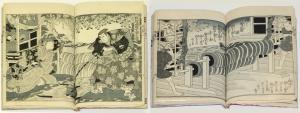What Really Happens in the Kyōgen Backstage (Okyogen Gakuya no Honsetsu)
Written by Santei Shunba and painted by Utagawa Kunitsuna 1859 (Ansei 6) Kaga Collection 6039
This material offers explanations mainly through picture on the tools and works, which were used for backstage devices of Kabuki. This helps us to learn about dramaturgy of Kabuki, including stage sets and theater properties.
With the growing popularity of ghost story-related plays since the Bunka and Bunsei periods (1804-1830), the large scale devices were developed by Hasegawa Kanpei, a professional set designer/producer, who handled all the stage sets at three officially recognized Kabuki theaters of Edo.
This page is one of the scenes of "Imoseyama Onna Teikin" and describes the devise of "takiguruma (waterfalls wheels)" that expresses the Yoshino River. Usually, pale blue cloth is used to express the flow of a river. In this play, however, this devise was used to make it appear as if the water flew from the back of the stage to the audience seats.
In addition, this work includes the burning lantern entrance (chōchin nuke), the revolving door panel (toita gaeshi), the garden lantern entrance (tōrō nuke) of "Ghost Story at Yotsuya on the Tōkaidō", and the disclosure of a trick for a midair stunt feat of Ishikawa Goemon. The books for trick disclosure were a popular project to satisfy the curiosity of the audience, and many other books based on similar ideas were also published.


